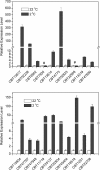Deep-sequencing transcriptome analysis of chilling tolerance mechanisms of a subnival alpine plant, Chorispora bungeana
- PMID: 23171377
- PMCID: PMC3571968
- DOI: 10.1186/1471-2229-12-222
Deep-sequencing transcriptome analysis of chilling tolerance mechanisms of a subnival alpine plant, Chorispora bungeana
Abstract
Background: The plant tolerance mechanisms to low temperature have been studied extensively in the model plant Arabidopsis at the transcriptional level. However, few studies were carried out in plants with strong inherited cold tolerance. Chorispora bungeana is a subnival alpine plant possessing strong cold tolerance mechanisms. To get a deeper insight into its cold tolerance mechanisms, the transcriptome profiles of chilling-treated C. bungeana seedlings were analyzed by Illumina deep-sequencing and compared with Arabidopsis.
Results: Two cDNA libraries constructed from mRNAs of control and chilling-treated seedlings were sequenced by Illumina technology. A total of 54,870 unigenes were obtained by de novo assembly, and 3,484 chilling up-regulated and 4,571 down-regulated unigenes were identified. The expressions of 18 out of top 20 up-regulated unigenes were confirmed by qPCR analysis. Functional network analysis of the up-regulated genes revealed some common biological processes, including cold responses, and molecular functions in C. bungeana and Arabidopsis responding to chilling. Karrikins were found as new plant growth regulators involved in chilling responses of C. bungeana and Arabidopsis. However, genes involved in cold acclimation were enriched in chilling up-regulated genes in Arabidopsis but not in C. bungeana. In addition, although transcription activations were stimulated in both C. bungeana and Arabidopsis, no CBF putative ortholog was up-regulated in C. bungeana while CBF2 and CBF3 were chilling up-regulated in Arabidopsis. On the other hand, up-regulated genes related to protein phosphorylation and auto-ubiquitination processes were over-represented in C. bungeana but not in Arabidopsis.
Conclusions: We conducted the first deep-sequencing transcriptome profiling and chilling stress regulatory network analysis of C. bungeana, a subnival alpine plant with inherited cold tolerance. Comparative transcriptome analysis suggests that cold acclimation is not a major chilling tolerance mechanism of C. bungeana. Activation of protein phosphorylation and ubiquitination may confer chilling tolerance to C. bungeana in a more rapid and flexible way than cold acclimation. Such differences may have contributed to the differences in cold tolerance between C. bungeana and Arabidopsis. The results presented in this paper will be informative for gene discovery and the molecular mechanisms related to plant cold tolerance.
Figures









Similar articles
-
Chilling- and Freezing-Induced Alterations in Cytosine Methylation and Its Association with the Cold Tolerance of an Alpine Subnival Plant, Chorispora bungeana.PLoS One. 2015 Aug 13;10(8):e0135485. doi: 10.1371/journal.pone.0135485. eCollection 2015. PLoS One. 2015. PMID: 26270551 Free PMC article.
-
Molecular cloning and characterization of a gamma-glutamylcysteine synthetase gene from Chorispora bungeana.Protoplasma. 2009 Mar;235(1-4):27-36. doi: 10.1007/s00709-008-0026-3. Epub 2008 Dec 12. Protoplasma. 2009. PMID: 19082776
-
Comparison with Arabidopsis reveals optimal nitrogen allocation strategy and mechanism in Chorispora bungeana, a cryophyte with strong freezing tolerance.J Plant Physiol. 2021 Jan;256:153311. doi: 10.1016/j.jplph.2020.153311. Epub 2020 Nov 13. J Plant Physiol. 2021. PMID: 33249387
-
Gene Regulatory Networks Mediating Cold Acclimation: The CBF Pathway.Adv Exp Med Biol. 2018;1081:3-22. doi: 10.1007/978-981-13-1244-1_1. Adv Exp Med Biol. 2018. PMID: 30288701 Review.
-
Physiological and Molecular Mechanism Involved in Cold Stress Tolerance in Plants.Plants (Basel). 2020 Apr 28;9(5):560. doi: 10.3390/plants9050560. Plants (Basel). 2020. PMID: 32353940 Free PMC article. Review.
Cited by
-
Comparative transcriptome analysis reveals phytohormone signalings, heat shock module and ROS scavenger mediate the cold-tolerance of rubber tree.Sci Rep. 2018 Mar 21;8(1):4931. doi: 10.1038/s41598-018-23094-y. Sci Rep. 2018. PMID: 29563566 Free PMC article.
-
Genome-wide identification and comparative analysis of grafting-responsive mRNA in watermelon grafted onto bottle gourd and squash rootstocks by high-throughput sequencing.Mol Genet Genomics. 2016 Apr;291(2):621-33. doi: 10.1007/s00438-015-1132-5. Epub 2015 Oct 26. Mol Genet Genomics. 2016. PMID: 26500104
-
Hormonal control of cold stress responses in plants.Cell Mol Life Sci. 2016 Feb;73(4):797-810. doi: 10.1007/s00018-015-2089-6. Epub 2015 Nov 23. Cell Mol Life Sci. 2016. PMID: 26598281 Free PMC article. Review.
-
Overexpression of Karrikins Receptor Gene Sapium sebiferum KAI2 Promotes the Cold Stress Tolerance via Regulating the Redox Homeostasis in Arabidopsis thaliana.Front Plant Sci. 2021 Jul 15;12:657960. doi: 10.3389/fpls.2021.657960. eCollection 2021. Front Plant Sci. 2021. PMID: 34335642 Free PMC article.
-
CbADH1 improves plant cold tolerance.Plant Signal Behav. 2019;14(7):1612680. doi: 10.1080/15592324.2019.1612680. Epub 2019 May 6. Plant Signal Behav. 2019. PMID: 31056000 Free PMC article.
References
-
- Fu XY, Chang JF, An LZ, Zhang MX, Xu SJ, Chen T, Liu YH, Xin H, Wang JH. Association of the cold-hardiness of Chorispora bungeana with the distribution and accumulation of calcium in the cells and tissues. Environ Exp Bot. 2006;55:282–293. doi: 10.1016/j.envexpbot.2004.11.009. - DOI
-
- Liu YJ, Zhao ZG, Si J, Di CX, Han J, An LZ. Brassinosteroids alleviate chilling-induced oxidative damage by enhancing antioxidant defense system in suspension cultured cells of Chorispora bungeana. Plant Growth Regul. 2009;59:207–214. doi: 10.1007/s10725-009-9405-9. - DOI
Publication types
MeSH terms
LinkOut - more resources
Full Text Sources

